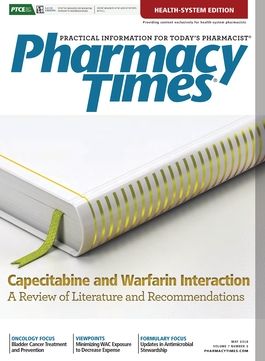Publication
Article
Pharmacy Practice in Focus: Health Systems
340B: Emerging From the Shadows
Author(s):
In this issue of Pharmacy Times® Health-System Edition, Grayson K. Peek, PharmD, and Halena Leah Marcelin, PharmD, offer a brief discussion of optimizing wholesale acquisition cost exposure for organizations participating in the federal 340B drug discount program when the group purchasing organization prohibition requirement applies.
In this issue of Pharmacy Times® Health-System Edition, Grayson K. Peek, PharmD, and Halena Leah Marcelin, PharmD, offer a brief discussion of optimizing wholesale acquisition cost exposure for organizations participating in the federal 340B drug discount program when the group purchasing organization prohibition requirement applies. That is a relatively obscure and technical detail related to compliance and efficient management of the 340B program. Public visibility of the program has increased considerably in the past few years, producing frequent mischaracterizations and misleading rhetoric concerning its public impact and purpose.
Congress established the federal 340B program in 1992 to extend Medicaid drug discounts to qualifying safety net providers to “stretch scarce federal resources as far as possible, reaching more eligible patients and providing more comprehensive services.” Eligible institutions can provide care and services to more underinsured and uninsured poor and rural patients than would be possible in the absence of the savings from program participation. An analysis of fiscal year 2015 data showed that 60% of the total unreimbursed and uncompensated care was being provided by the 38% of hospitals that were 340B-eligible, and 340B disproportionate share hospitals cared for significantly more low-income patients than non-340B eligible hospitals.1 The program is accomplishing the original intent of the legislation passed more than 25 years ago.
Contrary to criticism, the program is not intended to offer discounted prescription drug prices to low-income and uninsured patients. It also is not a misapplication of intent to use 340B-purchased drugs to fill prescriptions for or treat patients who can afford medications. It is intended to provide qualified covered entities with savings on the acquisition of drugs for outpatient use and use those savings to offset losses incurred when providing uncompensated or undercompensated clinical care to low-income and rural patients. Common undercompensated care provided by covered entities includes HIV/ AIDS treatment, mental health services, outpatient alcohol and drug abuse treatment, and obstetric, pediatric, primary care, and trauma care. The program provides billions of dollars of benefit to at-risk patients with essentially no direct cost to the taxpayer.
Critics also have suggested that there are frequent abuses, leading to inappropriately large financial windfalls for covered entities. In my home state, New York, 340B-eligible hospitals as a group have essentially break-even operating margins, with many reporting persistently negative margins. A reduction in 340B savings could have devastating financial consequences for these rural hospitals.2 It also would likely shift the cost of these services to the taxpayers to keep these safety net hospitals open. Although there is an obligation for all covered entities to invest in the resources and expertise to assure a high level of compliance with program requirements, the bulk of evidence suggests that most covered entities have compliant, well-managed programs.
The pharmaceutical industry has made the limitation and potential dismantling of the 340B program a priority. For the first quarter of 2018, the industry spent a near-record $10 million lobbying Congress, with the 340B program among several targets. That effort has coincided with hearings on the program in both the House and Senate, and multiple bills intended to alter the program have been introduced. In addition, CMS introduced changes to the outpatient prospective payment system that reduced reimbursement to 340B-eligible covered entities by $1.6 billion and redistributed those funds across all Medicare outpatient providers, regardless of their contribution to the care of at-risk patients. These attacks on the 340B program, if successful, could hurt the ability of safety net providers to continue to provide services to low-income patients, may shift more costs for services to taxpayers, and may lead to a decline in the infrastructure and technology available to patients in rural areas.
Curtis E. Haas, PharmD, FCCP, is the director of pharmacy for the University of Rochester health care system in New York.
References
- L&M Policy Research, LLC. Analysis of 340B disproportionate share hospital services to low-income patients. 340B Health website. 340bhealth.org/files/340B_Report_03132018_FY2015_final.pdf. Published March 12, 2018. Accessed April 24, 2018.
- Healthcare Association of New York State. HANYS’ 2018 federal priorities. Western New York Healthcare Association website. wnyha.org/wp-content/uploads/2018/01/Federal-Messaging-2018_HANYSWNYHA.pdf. Published January 2018. Accessed April 25, 2018.







